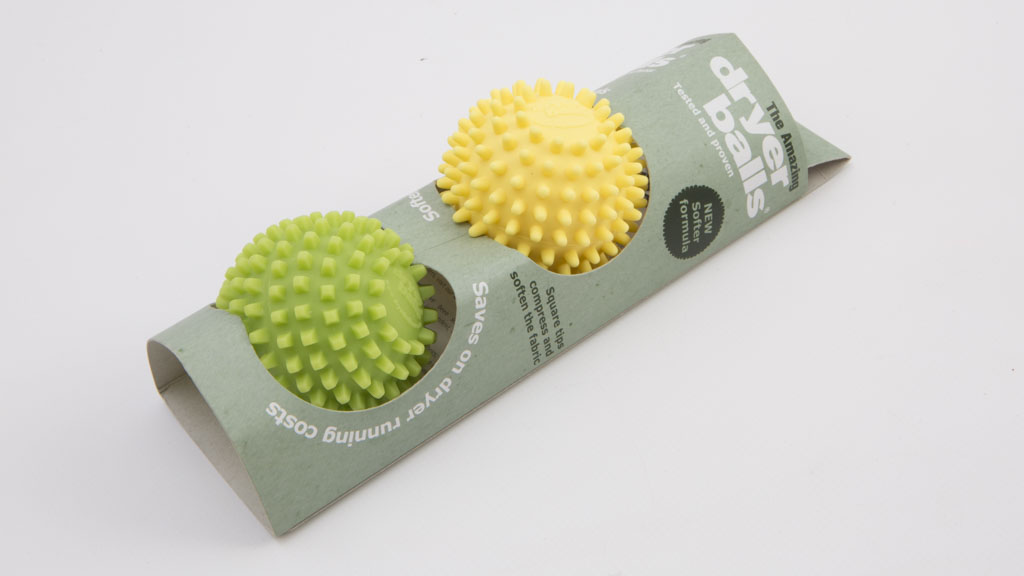Get our independent lab tests, expert reviews and honest advice.
Do dryer balls actually work?

Many years ago some bright spark suggested that putting a tennis ball into a dryer would help soften clothes and save you money by reducing drying time. Marketing gurus have cottoned onto this idea and introduced plastic or woollen dryer balls that claim to do the same thing. But do they actually work? We put four brands of dryer balls to the test to find out.
On this page:
Do dryer balls work?
In short, not really. There are marginal differences, but in most cases dryer balls actually increase your costs by a very small amount. We tested with a conventional electric vented dryer and an upmarket condenser dryer both with and without the balls and compared the two. None of them had much of an impact on performance in either dryer.
So by all means if you want to throw your money towards this product, go ahead, but don’t be under any illusion that dryer balls will save you any money on running costs, or even reduce the time it takes to dry a load of clothes.
Products we looked at

Pacific Air Clothes Dryer Balls
Type: Plastic
Price paid: $16.95
Claim: Faster drying.
Conclusion: No faster drying.

Wooly Mates Dryer Balls
Type: Wool
Price paid: $34.85
Claim: No claim on drying time made.

Ecozone Amazing Dryer Balls
Type: Plastic
Price paid: $17.95
Claim: Reduce drying time by up to 25%
Conclusion: Increased drying time by 3.9%

Ms Fix-It Dryer Balls
Type: Plastic
Price paid: $6.50
Claim: Faster drying.
Conclusion: Increased drying time by 5.2%
Dryer ball test results
Pacific Air Clothes Dryer balls
Type: Plastic
Price paid: $16.95
Number of balls used: 3
Energy used (condenser dryer): 2.48kWh
Energy used (electric vented dryer): 4.02kWh
Difference in energy use (condenser dryer): 0.01kWh
Difference in energy use (electric vented dryer): -0.06kWh
Cost or savings per run (condenser dryer): Costs you $0.005 per run
Cost or savings per run (electric vented dryer): Saves you $0.025 per run
Wooly Mates Dryer Balls
Type: Wool
Price paid: $34.85
Number of balls used: 6
Energy used (condenser dryer): 2.61kWh
Energy used (electric vented dryer): 4.01kWh
Difference in energy use (condenser dryer): 0.15kWh
Difference in energy use (electric vented dryer): -0.07kWh
Cost or savings per run (condenser dryer): Costs you $0.058 per run
Cost or savings per run (electric vented dryer): Saves you $0.026 per run
Ecozone Amazing Dryer Balls
Type: Plastic
Price paid: $17.95
Number of balls used: 2
Energy used (condenser dryer): 2.57kWh
Energy used (electric vented dryer): 4.12Wh
Difference in energy use (condenser dryer): 0.11kWh
Difference in energy use (electric vented dryer): 0.04kWh
Cost or savings per run (condenser dryer): Costs you $0.044 per run
Cost or savings per run (electric vented dryer): Costs you $0.015 per run
Ms Fix-It Dryer Balls
Type: Plastic
Price paid: $6.50
Number of balls used: 2
Energy used (condenser dryer): 2.62kWh
Energy used (electric vented dryer): 4.14Wh
Difference in energy use (condenser dryer): 0.15kWh
Difference in energy use (electric vented dryer): 0.06kWh
Cost or savings per run (condenser dryer):Costs you $0.060 per run
Cost or savings per run (electric vented dryer): Costs you $0.025 per run
How we tested dryer balls
We compared each of the products with a separate run without dryer balls in each dryer type (electric vented and condenser). We used identical loads and program types. We measured against the final mass and energy usage for the conventional electric vented dryer and we compared against mass, time and electricity with regards to the condenser dryer.
We’ve only displayed energy usage because this is the difference you’ll see in your energy bill. We used a 3.5kg IEC cotton load that we use for all our dryer (and washing machine) tests. We based the energy cost calculation on $0.40 per kWh.
Electric vented dryer we used: Simpson 39P400M
Condenser dryer we used: Miele T8929WP
Apart from the Wooly Mates dryer balls, all of the dryer balls we looked at are plastic, and only the Wooly Mates ones claimed to be made in Australia – the rest didn’t say where they were made at the time of testing.
CHOICE Verdict
Don’t bother buying these products to save you money by speeding up your drying times and using less energy. Quite simply, they don’t work.
Dryer balls also claim to make clothes softer, which we haven’t tested, but you can just give your clothes a flick when they come out of the wash and that should add some air to the fabric (products like fabric softeners are often a waste of money).






